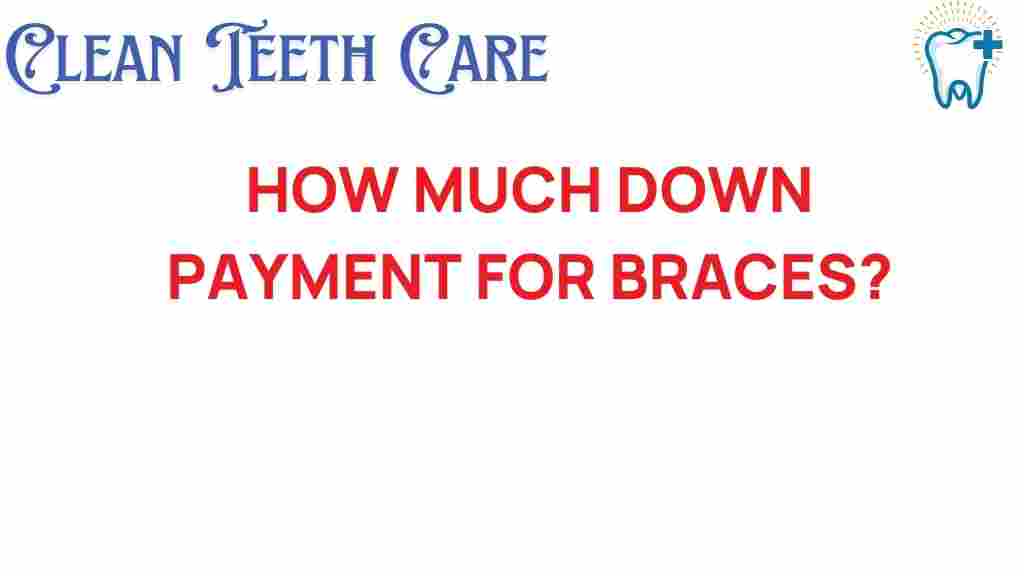Unlocking the Mystery: How Much Down Payment for Braces?
When considering braces, many patients and parents often have questions about the financial implications. One of the most frequent inquiries is, “How much down payment for braces?” Understanding the costs associated with orthodontics is crucial for effective dental care planning. This article will guide you through the various aspects of financing braces, including down payments, insurance coverage, payment plans, and the overall importance of oral health.
Understanding the Cost of Braces
The cost of braces can vary significantly based on several factors, including:
- Type of braces: Traditional metal braces, ceramic braces, lingual braces, and clear aligners each come with different price tags.
- Duration of treatment: The length of time you need to wear braces affects the total cost.
- Orthodontist’s expertise: Highly experienced orthodontists may charge more for their services.
- Your geographical location: Costs can differ based on where you live.
On average, the total cost for braces can range from $3,000 to $7,000. However, the down payment for braces can vary widely depending on the payment plan and insurance options available.
How Much is the Down Payment for Braces?
The down payment for braces generally falls between $500 and $1,500. This amount is often a percentage of the total cost of treatment. Here’s a breakdown of how it typically works:
1. Determining Total Cost
Before you can figure out your down payment, you need to know the total cost of your braces. Schedule a consultation with an orthodontist to get a precise estimate based on your specific needs.
2. Understanding Payment Plans
Most orthodontists offer flexible payment plans. Here are some common options:
- Monthly payment plans: After the down payment, you can pay the remaining balance in monthly installments, typically spread over 12 to 24 months.
- Interest-free financing: Some offices provide interest-free financing options, making it easier to manage payments.
- Sliding scale payments: Based on income, some orthodontists may offer reduced payments.
3. Insurance Coverage
Many dental insurance plans cover a portion of orthodontic treatment. Here’s how to leverage insurance to reduce your down payment:
- Check your plan: Review your dental insurance policy to see what orthodontic services are covered.
- Pre-authorization: Consider getting a pre-authorization from your insurance provider to understand your benefits.
- Maximize your benefits: Some plans have a lifetime maximum for orthodontic treatment, so be sure to utilize this if applicable.
Financing Options for Braces
If your insurance does not cover the entire cost of braces, consider these financing options:
- Health Savings Accounts (HSAs): You can use pre-tax dollars from HSAs to pay for orthodontic treatment.
- Credit options: Some providers offer financing through third-party credit companies that specialize in dental care.
- Personal loans: Consider taking out a personal loan to cover the costs if necessary.
Step-by-Step Process to Get Started
Here’s a step-by-step guide to help you get started with your braces journey:
Step 1: Schedule a Consultation
Find an orthodontist who can assess your needs and provide a detailed cost estimate.
Step 2: Discuss Payment Options
During your consultation, talk about down payment options, monthly payments, and any available financing plans.
Step 3: Review Insurance Benefits
Consult with your insurance provider to understand what is covered and how it impacts your down payment.
Step 4: Finalize Your Payment Plan
Once you have all the information, decide on a payment plan that fits your budget and lifestyle.
Step 5: Begin Treatment
After your down payment is made and financing is set, you can begin your orthodontic treatment!
Common Troubleshooting Tips
If you encounter issues with financing your braces, consider these troubleshooting tips:
1. Budgeting Wisely
Ensure you have a clear budget to accommodate the ongoing costs of braces.
2. Communicate with Your Orthodontist
If you’re struggling to make payments, communicate with your orthodontist. They may be able to offer alternative solutions.
3. Explore Additional Financing Options
If your initial financing plan isn’t feasible, explore other options or consult a financial advisor.
The Importance of Oral Health
Investing in braces is not just about aesthetics; it plays a crucial role in oral health:
- Improved bite: Proper alignment can enhance your bite, reducing wear on teeth.
- Easier cleaning: Straight teeth are easier to clean, which helps prevent cavities and gum disease.
- Boosted confidence: A beautiful smile can improve self-esteem and social interactions.
Conclusion
Understanding how much down payment for braces is essential for planning your orthodontic treatment. By exploring various payment options, leveraging insurance, and discussing flexible financing plans with your orthodontist, you can make braces more affordable. Remember, investing in braces is an investment in your oral health and overall confidence. If you wish to learn more about orthodontic treatment and payment options, consult your local orthodontist or visit this resource for additional insights.
For further reading on dental care financing options, you can check this informative article.
This article is in the category Treatments and created by CleanTeethCare Team
